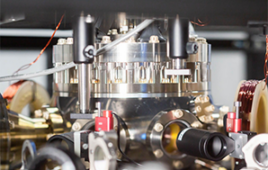Mammoth Blood Brought Back to Life with Ancient DNA
 |
| The structural model of the mammoth hemoglobin, with the three key changes to the protein highlighted in red. Illustration by Ansgar Philippsen |
A team of international researchers has brought the primary component of mammoth blood back to life using ancient DNA preserved in bones from Siberian specimens 25,000 to 43,000 years old. Studies of recreated mammoth hemoglobin, published May 3, 2010, in Nature Genetics, reveal special evolutionary adaptations that allowed the mammoth to cool its extremities down in harsh Arctic conditions to minimize heat loss.
“It has been remarkable to bring a complex protein from an extinct species, such as the mammoth, back to life,” says Alan Cooper, Director of the Australian Centre for Ancient DNA (ACAD) at the University of Adelaide, where the mammoth hemoglobin sequences were determined. “This is true paleobiology, as we can study and measure how these animals functioned as if they were alive today.”
Cooper is an Australian Research Council Future Fellow and a member of the University’s Environment Institute.
“We’ve managed to uncover physiological attributes of an animal that hasn’t existed for thousands of years,” says team leader Kevin Campbell of the University of Manitoba, Canada. “Our approach opens the way to studying the biomolecular and physiological characteristics of extinct species, even for features that leave no trace in the fossil record.”
The project began over seven years ago when Campbell contacted Cooper, who was then based at the University of Oxford, to suggest resurrecting mammoth hemoglobin.
“At the time, I thought ‘what a great idea’ — but it’s never going to work,” says Cooper. “Still, bringing an extinct protein back to life is such an important concept, we’ve got to try it.”
The team converted the mammoth hemoglobin DNA sequences into RNA, and inserted them into modern-day E. coli bacteria, which then manufactured the authentic mammoth protein.
“The resulting hemoglobin molecules are no different than ‘going back in time’ and taking a blood sample from a real mammoth,” says Professor Campbell.
The team used modern scientific physiological tests and chemical modeling to characterize the biochemical properties that confer mammoths with physiological cold tolerance. Team member Roy Weber of the University of Aarhus, Denmark, who performed the physiological testing on the mammoth proteins, says the findings help show how the mammoth survived the extreme Arctic cold.
“Three highly unusual changes in the protein sequence allowed the mammoth’s blood to deliver oxygen to cells even at very low temperatures, something that indicates adaptation to the Arctic environment,” Weber says.
“We can now apply similar approaches to other extinct species, such as Australian marsupials,” says team member Jeremy Austin, ACAD Deputy Director, who is currently using ancient DNA to study the evolution of the extinct thylacine and the endangered Tasmanian Devil.



